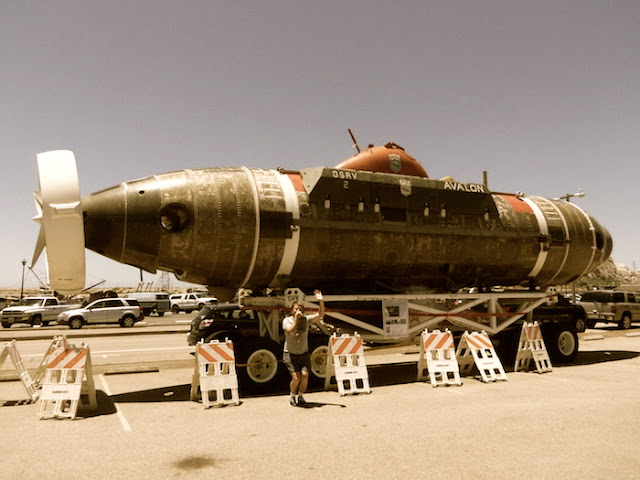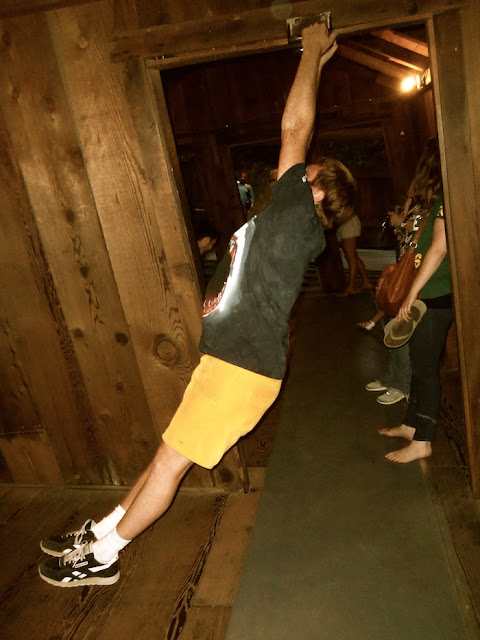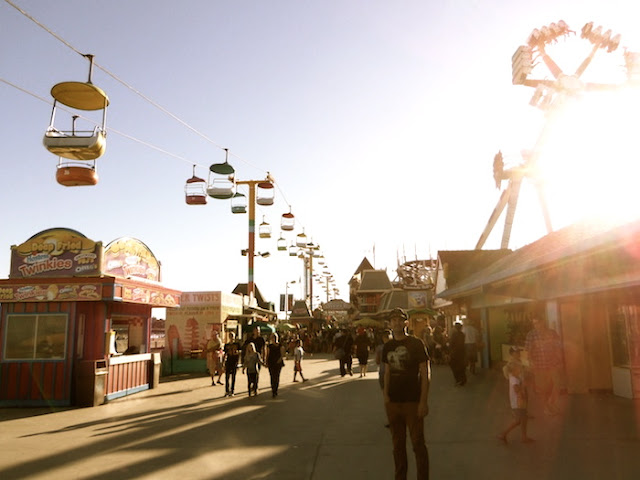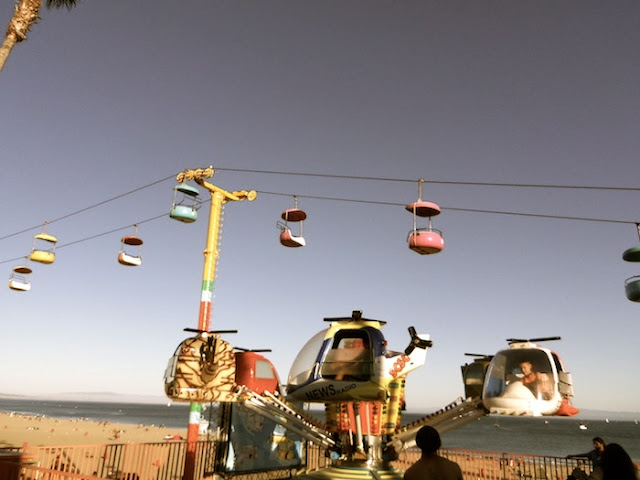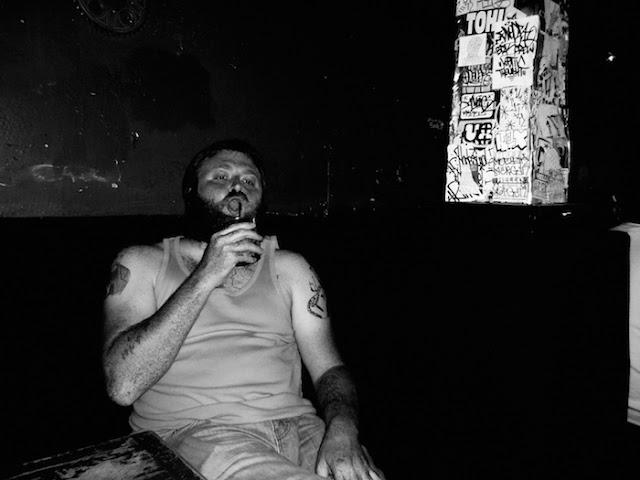 |
| Pacific Coast Highway |
On Sunday, my best friend Landon and I headed up highway 101 with no real agenda except to see the coast. We had a road map and a book my friend Chuck got me called Weird California: Your Travel Guide to California's Local Legends and Best Kept Secrets. Our first stop was a giant Santa Claus statue in Oxnard, CA. He was wearing shades and had a snowman sidekick with a surf board. We were off to a good start.
Next we headed to Mission Santa Barbara. After studying California history recently, I have a renewed interest in the Missions. In school, we are taught that they were these quaint places where Spanish monks lived. The reality is a little darker. The California Mission system was sort of like west coast slavery. The Spanish used missions as a way to push Native Americans off their land and force them to abandon their way of life.
 |
| "The Native Americans probably used this to grind maize." --Landon |
 |
| "Jesus loves you. Now get back to work." |
 |
| This is where Spanish missionaries and soldiers taught the Native Americans the ways of Christianity and forced labor. |
 |
| Father Serra says, "I will civilize these savages. They are living far too sustainably." |
Next we headed up to the tiny town of Guadalupe, near Santa Barbara. We'd read in Weird California that the famous Hollywood director Cecil B. DeMille filmed his original (1923) version of The Ten Commandments on these sandy dunes. DeMille had giant plaster Sphynxes and Egyptian sets built for the film. Afterward, he buried them under the shifting sands of the dunes. While we did not find any sphinxes, the park ranger told us that an archeological dig was scheduled for next year. Sphynxes or no, the dunes were incredibly beautiful. It sort of felt like Egypt. Good location scouting, Cecil B. DeMille!
 |
| "Let my people go!" |
We decided to spend the night in San Luis Obispo, and stayed at the historic Madonna Inn, which opened in 1958.
According to Weird California: "Of the 109 rooms at the Madonna Inn, each has a unique theme: the Caveman Room features rock walls and zebra-print sheets on the bed, while the Pick & Shovel Room has tractor seats for barstools, a thirty-one foot leather couch, and sleeps nine." Me and Landon stayed in the Cayucas Queen room which looked like this:
 |
| "These beds aren't ornate enough for me." --Landon |
 |
| "This is how I roll." |
That night, we went out for drinks in downtown San Luis Obispo and checked out Bubblegum Alley, a random alley that people have been sticking their bubble gum on for decades.
 |
| "Smells like bubble gum." |
We also did a little karaoke.
In the morning, we visited Mission San Luis Obispo. We arrived right before Mass began. Like most missions, the peaceful atmosphere masks a rather brutal history.
Our next stop was Morro Bay, which seems to be a popular tourist town. It's most notable feature is the giant dome-shaped Morro Rock.
We found a random submarine.
One disturbing thing about Morro Bay is that there is a giant factory of some sort right next to the beach, which casts an ominous feeling over the swimming tourists.
Continuing north on Pacific Coast Highway, we stopped at another destination mentioned in Weird California: "He was known as Captain Nitt Witt. He was also known as Der Tinkerpaw. To the residents of the coastal community of Cambria, however, he was probably best known as that crazy old guy who lives in that weird three-story house that he carved in the side of a hill using little more than hand tools, all the while stealing pieces of lumber and Lord knows what else from Hearst Castle, as well as neighborhood junk yards." The real Nitt Witt was named Art Beal, a local hermit who worked at Hearst Castle and spent his free time stealing shit and building an awesome house. Nitt Witt ridge is a marvel, and has come to be called a "Poor Man's Hearst Castle."
Our next destination was the real Hearst Castle, a place I'd heard about but never actually visited. I knew it was built by newspaper mogul William Randolph Hearst, who was famously represented in the movie Citizen Kane, directed by Orson Welles. Xanadu, the palatial residence that Kane builds for himself in the movie was modeled after Hearst Castle. The place was a strange mixture of creepy and astonishing.
Landon and I took the "Grand Rooms" tour. To get to the "castle" you have to take a bus way up into the hills of San Simeon. It is not accessible any other way. As we rode the bus up through the sprawling hills of the Hearst Ranch, we were treated to a voice recording of Alex Trebec (from Jeopardy) telling us about the life and times of Mr. Hearst, who in his day was one of the most powerful men in the world. He realized that real power did not reside in gold or cows, but in media. "I can destroy a man in one day," he once said.
As we arrived at the crest of the hill, we were greeted with this astonishing sight, which was basically Hearst's living room.
It was modeled after a church in Spain. It is very interesting that Hearst would model his house after a church. The whole place seems to be a holy monument to the man's enormous ego. It got me thinking about how, in America, we don't really have cathedrals like they have in Europe. Here, we have mansions and skyscrapers. Here the real power is not with the church, but with business.
The "grand rooms" of Hearst Castle were decorated with an impressive collection of ancient and European artworks, but what struck me was the juxtaposition of great works of art next to ordinary American pastimes. Thus, a 14th century tapestry hangs beside a pool table. At the center of a medieval dining room table are bottles of Heinz ketchup and mustard.
Outside, among the sprawling courtyards, is the Neptune pool. According to our tour guide, this is where movie stars like Cary Grant and Charlie Chaplin liked to take their lady friends.
The view from Hearst Castle is astonishing.
We continued up Pacific Coast Highway, which is an incredibly beautiful drive right along the coast, and stopped to admire Big Sur.
Driving along PCH, we were compelled to pull over a few times to take in the scenery.
Our next destination was Monterey, which is a strange town. It has a very blue collar, working class history, as depicted in John Steinbeck's novels like Cannery Row and Tortilla Flats. Now, however, it is a ritzy tourist town where rich people visit and live. I'm not sure Steinbeck would recognize it these days. There are, however, remnants of the once-bustling sardine industry.
We saw some sea lions.
We rented bikes and rode along the coast.
On our ride, we saw some deer. I didn't know deer lived by the ocean.
We also saw a squirrel climbing around on the rocks.
At the end of our bike journey was a light house built in the 1800s.
We continued north to the famous Mystery Spot in Santa Cruz. It's an old cabin built in the 1930s where the laws of gravity do not seem to apply. Our tour guide suggested that the mysterious forces at work in the Mystery Spot are the result of a UFO crash. Whatever the reason, this is a cool place, situated in the middle of a gorgeous forest.
We checked into a motel in Santa Cruz and spent the evening cruising the historic Boardwalk. A woman I met described Santa Cruz as "a shady town with a huge drug problem." As we walked down the Boardwalk with our alcoholic beverages, I definitely saw some shady characters. Landon suggested I hold onto my wallet so it wouldn't get stolen by drug-crazed tweakers.
Meth addicts notwithstanding, the Boardwalk is a fascinating slice of Americana, with its carnival rides, games, and deep fried food. Landon and I rode two rides and they were more thrilling than anything Disneyland has to offer.
That night, we went to a sweet dive bar called Brady's Yacht Club. They had a great juke box. The bartender, also named Jesse, happened to know a lot about Fullerton punk bands like The Adolescents, Agent Orange, and the Middle Class. He got Landon a free beer.
No trip up the California coast would be complete without hiking in a redwood forest. The next day, we took a strenuous hike through Big Basin. Living in southern California, I don't think about redwoods too much. But walking among these thousand year old trees, I was blown away. Redwoods are the tallest organisms in the world, and the oldest. We got talking about reality shows about the logging industry. Landon said, "The lumberjacks always say they are cutting down trees in a sustainable way. But what is sustainable about cutting down trees that are hundreds of years old?"
We'd recently seen a film about how the state of California is considering shutting down 70 of its state parks, to save money. If anyone thinks that is a good idea, they need only visit Big Basin and it will change your mind.
 |
| This tree sprouted during the reign of Byzantine emperor Justinian, over 1,300 years ago. |
Our final stop was San Francisco, to visit our friends and former band-mates Brian and Christie. After a long journey in unfamiliar places, it felt good to be with friends. We had some drinks and pizza and played music. Good times. if you are an artist of any kind, San Francisco is a beautiful place to be. There is public art everywhere and lots of amazing cultural happenings. San Francisco is a city of dreams.
The view from the rooftop of Brian and Christie's apartment building in the Mission District of SF. Gorgeous.
After saying goodbye to Brian and Christie, we left SF and zipped back home down I-5. I don't know if I found the California Dream, but I certainly found some beautiful places. Despite all its problems, California is still a place of astonishing grandeur and strangeness. During our travels, Landon and I got talking about life. We agreed that, because we only get the one life, we'd better not waste it. We agreed that it is important to follow our dreams, and not be afraid.
























